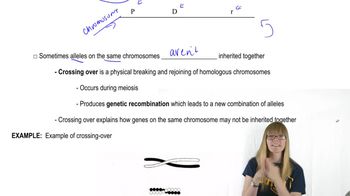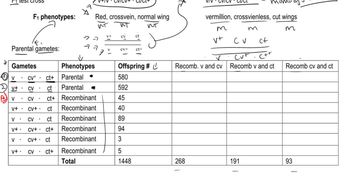Using the following data collected from a test cross, calculate the recombination frequency.
Table of contents
- 1. Introduction to Genetics51m
- 2. Mendel's Laws of Inheritance3h 37m
- 3. Extensions to Mendelian Inheritance2h 41m
- 4. Genetic Mapping and Linkage2h 28m
- 5. Genetics of Bacteria and Viruses1h 21m
- 6. Chromosomal Variation1h 48m
- 7. DNA and Chromosome Structure56m
- 8. DNA Replication1h 10m
- 9. Mitosis and Meiosis1h 34m
- 10. Transcription1h 0m
- 11. Translation58m
- 12. Gene Regulation in Prokaryotes1h 19m
- 13. Gene Regulation in Eukaryotes44m
- 14. Genetic Control of Development44m
- 15. Genomes and Genomics1h 50m
- 16. Transposable Elements47m
- 17. Mutation, Repair, and Recombination1h 6m
- 18. Molecular Genetic Tools19m
- 19. Cancer Genetics29m
- 20. Quantitative Genetics1h 26m
- 21. Population Genetics50m
- 22. Evolutionary Genetics29m
4. Genetic Mapping and Linkage
Mapping Genes
Problem 8b
Textbook Question
Gene G recombines with gene T at a frequency of 7%, and gene G recombines with gene R at a frequency of 4%.
Assuming that organisms with any desired genotype are available, propose a genetic cross whose result could be used to determine which of the proposed genetic maps is correct.
 Verified step by step guidance
Verified step by step guidance1
Start by understanding that recombination frequency is directly proportional to the physical distance between genes on a chromosome. A recombination frequency of 1% corresponds to 1 map unit (or centimorgan, cM). Gene G recombines with gene T at 7% (7 cM), and gene G recombines with gene R at 4% (4 cM).
Propose two possible genetic maps based on the given recombination frequencies: (1) G is between T and R, with T-G = 7 cM and G-R = 4 cM, or (2) T and R are on opposite sides of G, with T-G = 7 cM and G-R = 4 cM. The total distance between T and R in the second case would be 7 cM + 4 cM = 11 cM.
Design a genetic cross to test these maps. Cross a double heterozygote (e.g., TtGgRr) with a triple homozygous recessive individual (e.g., ttggrr). This is a test cross, which allows you to observe the recombination events in the offspring.
Analyze the offspring phenotypes and their frequencies. The parental phenotypes will be the most frequent, while recombinant phenotypes will be less frequent. Identify the double recombinants (least frequent phenotypes) to determine the gene order.
Compare the observed recombination frequencies between the genes in the offspring to the proposed genetic maps. The correct map will match the observed recombination frequencies, confirming the gene order and distances.
 Verified video answer for a similar problem:
Verified video answer for a similar problem:This video solution was recommended by our tutors as helpful for the problem above
Video duration:
3mPlay a video:
Was this helpful?
Key Concepts
Here are the essential concepts you must grasp in order to answer the question correctly.
Recombination Frequency
Recombination frequency is a measure of the likelihood that two genes will be separated during meiosis due to crossing over. It is expressed as a percentage, indicating the proportion of offspring that exhibit recombinant phenotypes. In this case, gene G's recombination frequencies with genes T and R are 7% and 4%, respectively, which suggests their relative positions on a genetic map.
Recommended video:
Guided course

Recombination after Single Strand Breaks
Genetic Mapping
Genetic mapping is the process of determining the location of genes on a chromosome and the distances between them based on recombination frequencies. By analyzing the outcomes of genetic crosses, researchers can create maps that illustrate the arrangement of genes. The distances between genes can be inferred from the recombination frequencies, allowing for the construction of a genetic map that reflects their physical proximity.
Recommended video:
Guided course

Mapping Overview
Test Cross
A test cross involves breeding an individual with a homozygous recessive organism to determine the genotype of the first individual based on the phenotypes of the offspring. This method is useful for revealing the genetic makeup of an organism, especially when assessing the linkage and arrangement of genes. In the context of the question, a test cross could help clarify the genetic relationships between genes G, T, and R by analyzing the resulting offspring's phenotypes.
Recommended video:
Guided course

Trihybrid Cross
Related Videos
Related Practice
Multiple Choice
1096
views
5
rank
1
comments


